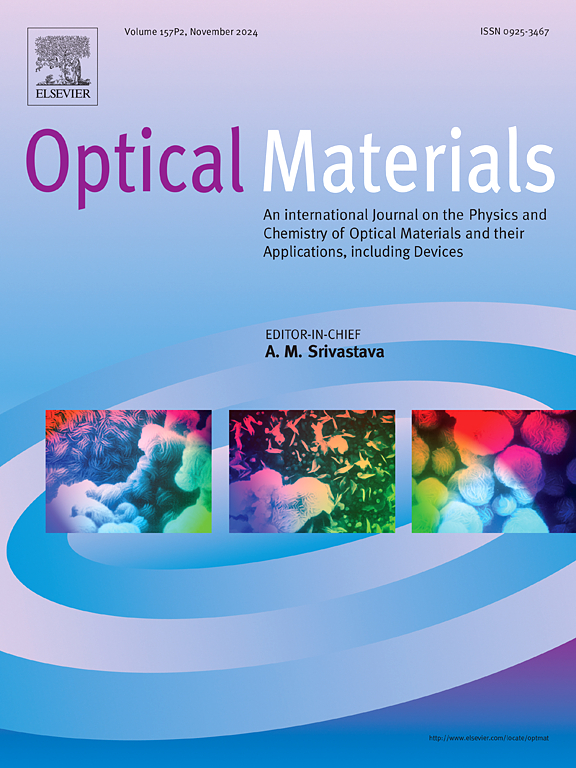Encapsulated multi-resonance TADF dendrimer with AIEE property for efficient solution-processed narrowband deep-blue OLEDs
IF 3.8
3区 材料科学
Q2 MATERIALS SCIENCE, MULTIDISCIPLINARY
引用次数: 0
Abstract
The utilization of multiple resonances (MR) thermally activated delayed fluorescence (TADF) materials for solution-processed organic light-emitting diodes (OLEDs) faced notable challenges in severe aggregation-caused quenching (ACQ) issues. Here, we successfully developed a narrow-band deep blue MR-TADF dendrimer (2CzphQAO) for solution-processed OLEDs by introducing three flexible carbazole branches around carbonyl/N emissive core as encapsulated unit. The branches connected by alkyl chains can not only effectively avoid the severe aggregation quenching of narrowband emission, but also improve its solubility in conventional organic solvents. In addition, 2CzphQAO also exhibits clear aggregation-induced emission enhancement (AIEE) properties in the molecular packaging state, which can effectively promote exciton utilization without causing spectral broadening. The resultant encapsulated MR-TADF dendrimer was able to show bright deep-blue emission peaked at 438 nm with a full width at half maximum (FWHM) of 47 nm. The solution-processed OLEDs based on the dendrimer achieved a maximum external quantum efficiency (EQE max) of 12.1 % with Commission Internationale de l’Eclairage (CIE) coordinate of (0.13,0.14), which is among the promising device efficiency of solution-processed narrowband deep blue OLEDs. This study demonstrates that the encapsulation of rigid MR-TADF molecule will be a feasible strategy for design efficient solution-processable OLEDs with high color purity.
具有AIEE特性的封装多共振TADF树状聚合物用于高效溶液处理的窄带深蓝oled
多共振(MR)热激活延迟荧光(TADF)材料在溶液处理有机发光二极管(oled)中的应用面临着严重的聚集引起的猝灭(ACQ)问题。本文通过在羰基/N发射核周围引入三个柔性咔唑支作为封装单元,成功地开发了一种用于溶液处理oled的窄带深蓝MR-TADF树状分子(2CzphQAO)。烷基链连接的支链不仅可以有效避免窄带发射的剧烈聚集猝灭,而且可以提高其在常规有机溶剂中的溶解度。此外,在分子封装状态下,2CzphQAO还表现出明显的聚集诱导发射增强(AIEE)特性,可以有效地促进激子的利用,而不会引起光谱展宽。所得到的包封MR-TADF树状大分子能够在438 nm处显示明亮的深蓝色发射峰,半峰宽(FWHM)为47 nm。基于树突状聚合物的溶液处理oled的最大外量子效率(EQE max)为12.1%,国际发光委员会(CIE)坐标为(0.13,0.14),是溶液处理窄带深蓝oled中最有前途的器件效率之一。该研究表明,刚性MR-TADF分子的封装将是设计具有高颜色纯度的高效溶液可处理oled的可行策略。
本文章由计算机程序翻译,如有差异,请以英文原文为准。
求助全文
约1分钟内获得全文
求助全文
来源期刊

Optical Materials
工程技术-材料科学:综合
CiteScore
6.60
自引率
12.80%
发文量
1265
审稿时长
38 days
期刊介绍:
Optical Materials has an open access mirror journal Optical Materials: X, sharing the same aims and scope, editorial team, submission system and rigorous peer review.
The purpose of Optical Materials is to provide a means of communication and technology transfer between researchers who are interested in materials for potential device applications. The journal publishes original papers and review articles on the design, synthesis, characterisation and applications of optical materials.
OPTICAL MATERIALS focuses on:
• Optical Properties of Material Systems;
• The Materials Aspects of Optical Phenomena;
• The Materials Aspects of Devices and Applications.
Authors can submit separate research elements describing their data to Data in Brief and methods to Methods X.
 求助内容:
求助内容: 应助结果提醒方式:
应助结果提醒方式:


